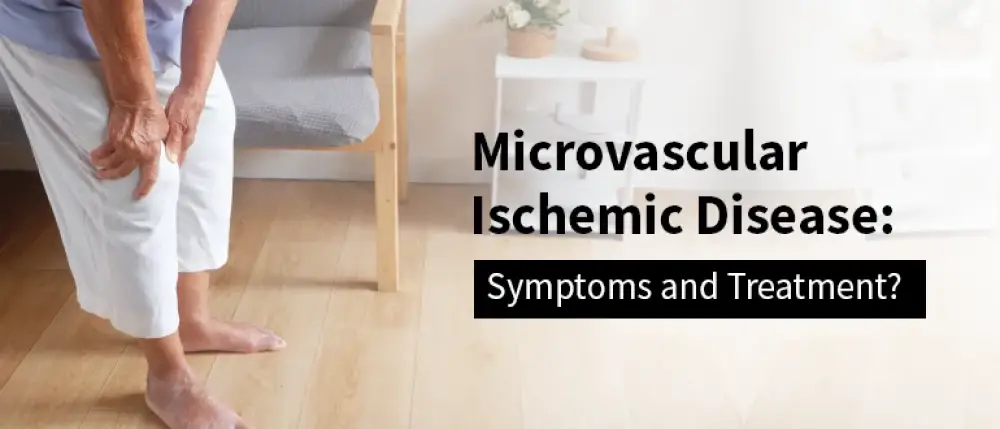Subscribe to get weekly insights
Always stay up to date with our newest articles sent direct to your inbox
Published on 11 Dec, 2023
Updated on 4 Nov, 2025
48847 Views
3 min Read

Written by Care Health Insurance
Reviewed by Care Health Insurance
favorite4Likes
Microvascular ischemic disease refers to disorders impacting the small blood vessels within the brain, encompassing conditions such as stroke, cerebral haemorrhage, and dementia. Microvascular ischemic brain disease risk factors include age, diabetes and high blood pressure. Notably, chronic ischemic microvascular disease can manifest in other organs, such as the heart, kidneys, or eyes.
This article offers more knowledge about microvascular ischemic brain disease, covering its symptoms, risks, microvascular ischemic disease causes, and potential treatments.
Doctors use the name microvascular ischemic disease to describe alterations in the walls of small blood vessels within a body organ. Conditions impacting these vessels can harm the white substance in the brain, which houses nerve fibres transmitting signals between various brain regions.
Microvascular ischemic brain disease is considered a ‘silent’ condition, meaning most individuals with it don't feel noticeable signs. However, health experts can identify signs through microvascular ischemic disease MRI scans. The ICD-10 code for microvascular ischemic disease, specifically chronic cerebral ischemia, is I67.82. The microvascular ischemic disease ICD 10 falls under the broader categories of diseases of the circulatory system.
This condition is prevalent among older adults and, if untreated, can contribute to cognitive decline, dementia, stroke, and difficulties with walking. Depending on the severity of these changes, complications can range from difficulty focusing to experiencing a stroke.
This condition goes by several names, including:
Microvascular ischemic disease in the brain ranges from low to severe. In many older adults, particularly those with a mild form, there may be no noticeable symptoms despite areas of damage in the brain, referred to as ‘silent’ disease.
Even without apparent symptoms, subtle changes in thinking and physical abilities may occur.
In more severe cases of small vessel disease, symptoms can include:
If small vessel disease leads to a stroke, symptoms may involve:
It's crucial to recognise that a stroke is a medical emergency requiring immediate attention and treatment.
Age plays a significant role in the risk of chronic ischemic microvascular disease. Some studies show that only 5% of individuals aged 50 are affected, whereas nearly 100% of those over 90 experience this condition.
Certain factors contributing to the risk of microvascular ischemic brain disease include:
Although the precise cause of chronic ischemic microvascular disease is not entirely understood, various factors can impact the blood vessels in the brain. For example, fatty tissue, plaque, or scar tissue build-up inside arteries can wholly or partially obstruct blood flow to the brain. Inadequate blood flow may lead to insufficient oxygen in some regions of the brain tissue, resulting in damaged tissue or an ischemic stroke.
>> Also Read: High Cholesterol Warning Signs
Healthcare providers use magnetic resonance imaging (MRI) to diagnose microvascular ischemic disease. MRI and the diagnostic process are painless imaging tests that generate clear brain images using a combination of a large magnet, radio waves, and a computer. Microvascular ischemic disease leads to various changes in the brain.
When examining your microvascular ischemic disease MRI images, healthcare providers may specifically look for distinct structural indicators, including:
Microvascular ischemic brain disease impacts tiny blood vessels with a diameter of fewer than 0.5 millimetres, making it challenging to detect and address through surgical procedures.
As outlined in some findings, treatment options involve lifestyle adjustments and medications aimed at lowering the risk of cognitive decline, stroke, and physical impairments.
Depending on an individual's risk factors, a doctor might suggest one or a combination of these microvascular ischemic disease treatment approaches:
Findings show that patients with microvascular problems had shorter microvascular ischemic disease life expectancy as compared to individuals with a disability-free life.
Microvascular ischemic disease in the brain may not always show symptoms, but it can add to the development of other medical conditions, including dementia and stroke. The likelihood of experiencing microvascular ischemic diseases tends to rise with age. You can discuss strategies to mitigate this risk with your healthcare provider. Engaging in regular exercise, implementing dietary adjustments, and considering medications to manage cholesterol and blood pressure can help in living with this disease.
This disease worsens the quality of life and once detected the treatment requires immediate medical attention with quality treatment. So spending money on health insurance early on is crucial. Health insurance plans from Care Health Insurance can provide financial protection and access to necessary medical care. This way you can address potential health challenges without facing overwhelming financial burdens.
We wish you good health.
Disclaimers: The above information is for reference purposes only: Policy Assurance and Claims at the underwriter's discretion.
Thyroid : मामूली नहीं हैं महिलाओं में थायराइड होना, जानें इसके लक्षण और घरेलू उपचार Vipul Tiwary in Diseases
शुगर कंट्रोल कैसे करे? जानें, डायबिटीज में क्या खाना चाहिए Vipul Tiwary in Health & Wellness
हाई ब्लड प्रेशर को तुरंत कंट्रोल कैसे करें? देखें इसके उपाय Vipul Tiwary in Diseases
पैरों में दर्द किस कमी से होता है? जानें, इसके घरेलू इलाज Vipul Tiwary in Health Insurance Articles
Gym Supplements: Muscle Magic or Marketing Madness? Leena Khowal in Diet & Nutrition
Save Money on Senior Health Insurance Under New IRDAI Rules! Sejal Singhania in Senior Citizens
Conversion Disorder: A Functional Neurological Disorder Symptoms & More! Sejal Singhania in Diseases
Top 10 Flaxseed Benefits Yash in Diet & Nutrition
Always stay up to date with our newest articles sent direct to your inbox
Loading...